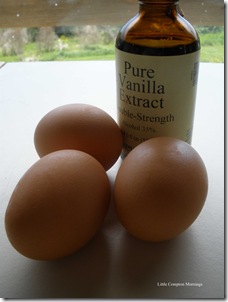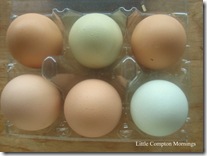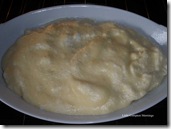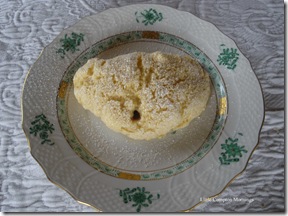 One of the few signs of spring around here is the appearance along the roadside of signs for local eggs. Most of our local eggs are brown, but we of course have white and increasingly will see lovely pale green eggs. Occasionally, as in the photo below right, they are packaged together, sort of like assorted chocolates.
One of the few signs of spring around here is the appearance along the roadside of signs for local eggs. Most of our local eggs are brown, but we of course have white and increasingly will see lovely pale green eggs. Occasionally, as in the photo below right, they are packaged together, sort of like assorted chocolates.Last year I provided excruciatingly detailed information on eggs and a recipe for mayonnaise. So I thought I’d skip the lecture and talk about something you don’t hear about too much: eggs for dessert. This is not a new idea by any means, as a perusal of my old cookery books shows. And if you think about it a minute, most of the desserts we eat—puddings, cakes—start out with eggs and sugar. With eggs for dessert, you just stop there. Brilliant!
Of course, everyone loves a good soufflé. That is certainly one dessert that can be made with eggs. It begins with a base such as pastry cream or fruit puree, and builds from there. But that’s a bit more than I am talking about. I really am talking about eggs and sugar—sweet omelets.

There are two kinds of sweet omelet: one plain, and very much a sweetened and sometimes flavored version of a regular omelet; and one souffléd, in which the whites are beaten and folded in. Both kinds have pretty much disappeared from the table in this country. I have no idea why, unless it’s the same reason that so many other things have disappeared from our tables: it didn’t lend itself to commercial production, and thus was lost to the generation that grew up on prepared food. Although while that might explain the disappearance of the souffléd omelet, a plain sweet omelet is no different from any other, and we all know we still eat way too many of those.
One could also argue that the sweet omelet is primarily a European thing, something of German, Viennese, or French provenance. My 1960s Mapie, Countess de Toulouse-Lautrec cookbook contains recipes for no less than eight simple sweet omelets. One contains angelica and has a butter sauce with grapes and rum. Yum.
But we Americans are not off the hook. My Gold Medal Flour cookbook—you can’t get more American than that—from 1910 has a recipe for a sweet omelet. And it is a souffléd one.
So no excuses. Try some eggs for dessert. Here are two versions of a souffléd omelet. If you fill your omelet, use your very best homemade, fluid-but-not-too-runny preserves.
Souffléd Omelet I
I first made this recipe at Roberta Dowling's Cambridge School of Culinary Arts, where I did my professional chef training. It is very similar to the Gold Medal recipe, and is very good. Serves 4-6.
5 eggs, separated
¼ cup sugar
¼ cup sifted flour
2 T unsalted butter
Preserves of your choice (I prefer cherry or apricot)
10x for garnish
Preheat the oven to 325 F. Beat egg whites stiff; fold in yolks, sugar, and flour gently. In a 9” frying pan, heat the butter and add the omelet mixture. Bake until slightly yellow, about 15 minutes. Fill with preserves; fold; and transfer to a platter. Sprinkle with 10x and serve.
Souffléd Omelet II
The confectioner’s sugar produces a softer texture, with a somewhat loose center; regular sugar yields a firmer omelet. Serves 3-4.
3 eggs, separated
1/3 cup 10x sugar, sifted and packed, or ¼ cup granulated sugar

½ tea vanilla
Pinch salt
1 ½ T flour
2 T homemade cherry or apricot preserves
Additional 10x to garnish
Preheat oven to 325 F. Beat the yolks and sugar with an electric beater; stir in the flour, salt, and vanilla. Beat the egg whites until stiff. Fold them, half at a time, into the egg yolk mixture. Using a large spoon, fill a buttered and sugared pie plate or small gratin with the egg mixture. Bake about 10-12 minutes, until firm to the touch and a skewer comes out clean. Sprinkle with confectioner’s sugar and serve immediately with the preserves or a fruit sauce (you can also put the preserves into the omelet for cooking: spoon half the batter into the pan, distribute the preserves, top with the remaining batter, and bake).



No comments:
Post a Comment